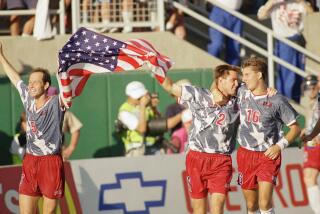THE CRUSADERS : For Kyle Rote Jr. and Others in the NASL, It Was a Mission of Marketing
- Share via
Now, the role belongs to Paul Caligiuri, who plays in Europe. Before that, it was property of Ricky Davis, now with the Tacoma Stars of the Major Indoor Soccer League, and, partly, Shep Messing, most recently a player-executive with the now-defunct MISL franchise in New York.
But Kyle Rote Jr., the son of the former Southern Methodist and New York Giants football star, was the first of that rare breed: The widely known American soccer star.
Now 36 and living in Memphis, Tenn., Rote, a broadcaster, motivational speaker for Fortune 500-type companies and head of a sports agency firm with former Chicago Cubs standout Don Kessinger, has a perspective on soccer in the United States unlike anyone else.
Also unlike most, he has watched the sport’s growing pains as a player and fan from the start. That was when the members of the Dallas Tornado used to joke that it would be quicker to introduce the fans in attendance than the players.
The Tornado, players included, were so aware of the importance of having a successful U.S. player in the foreign-dominated North American Soccer League that they didn’t mind if he missed hours, even a day, of practice to be somewhere promoting the sport.
They even made it a priority to get Rote the ball every time he was near the goal, in hopes that he would give Texas fans someone to identify with and win the scoring title, which he did as a second-year player in 1974.
“Back then, we had a much closer relationship,” he said recently. “It was a common bond with the suffrage. A lot of people had a missionary-like outlook when they were dealing with soccer.
“Players today count their (promotional) appearances, and when it gets inordinately high they start to complain. We’d go anywhere, anytime. It didn’t make a difference because we wanted to see soccer move from the status of being considered a foreign sport to where it would be an American sport for future generations.
“We all had a tremendous amount of satisfaction because we put so much effort into educating the American people to the game. . . . It became a cause. It wasn’t, ‘how many goals did you score?’ but ‘how many people did you put into the stands?’
“It was a good sort of pressure, and I felt very comfortable with that role. To some degree, it’s the same role Joe DiMaggio and Mickey Mantle had in an earlier era with another sport. I have had the privilege of being able to do it for soccer and I am honored by it.
“Every time I see a soccer ball in a commercial or in a game, I feel good about it. There’s a little twinkle in my eye and I say, ‘I’m a little part of why that youngster is doing that now.’ It sounds a little eerie, but it’s true. That is one thing no one can take away from me.”
More to Read
Go beyond the scoreboard
Get the latest on L.A.'s teams in the daily Sports Report newsletter.
You may occasionally receive promotional content from the Los Angeles Times.






